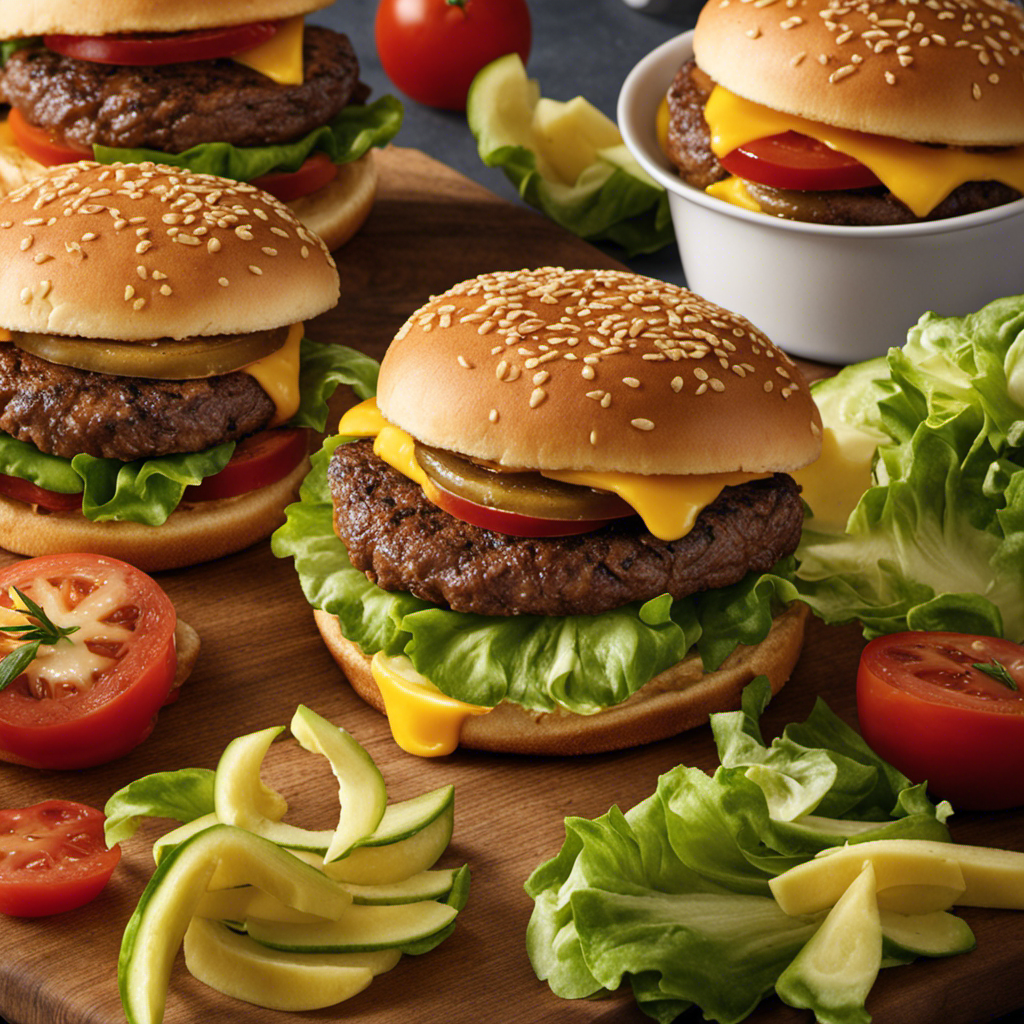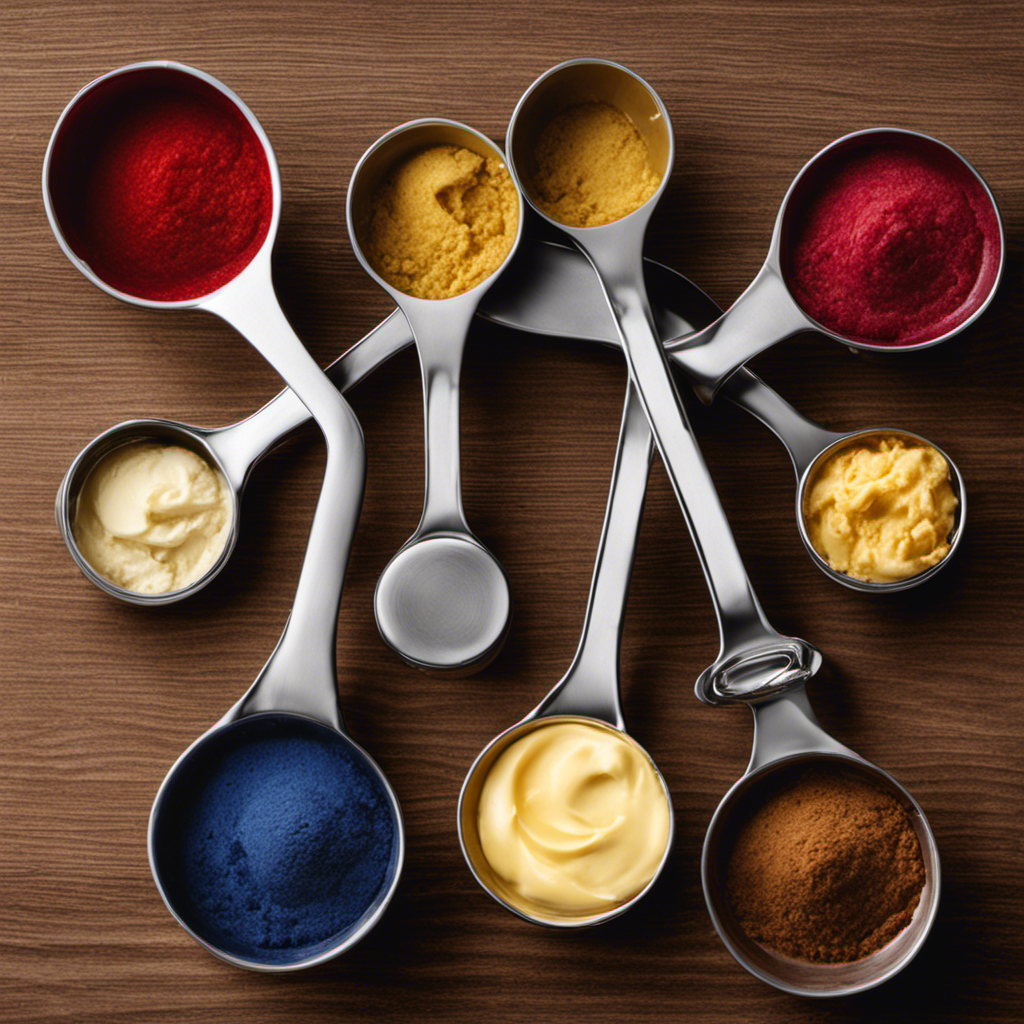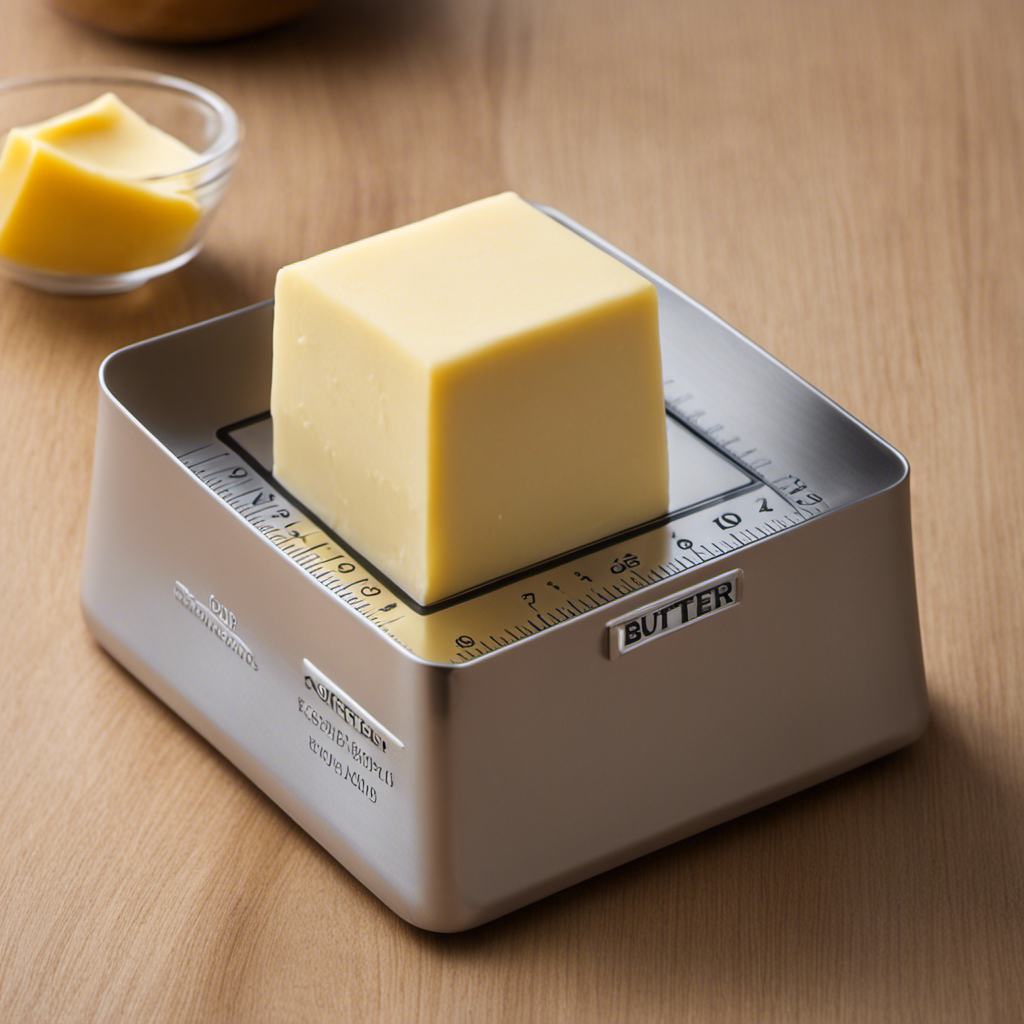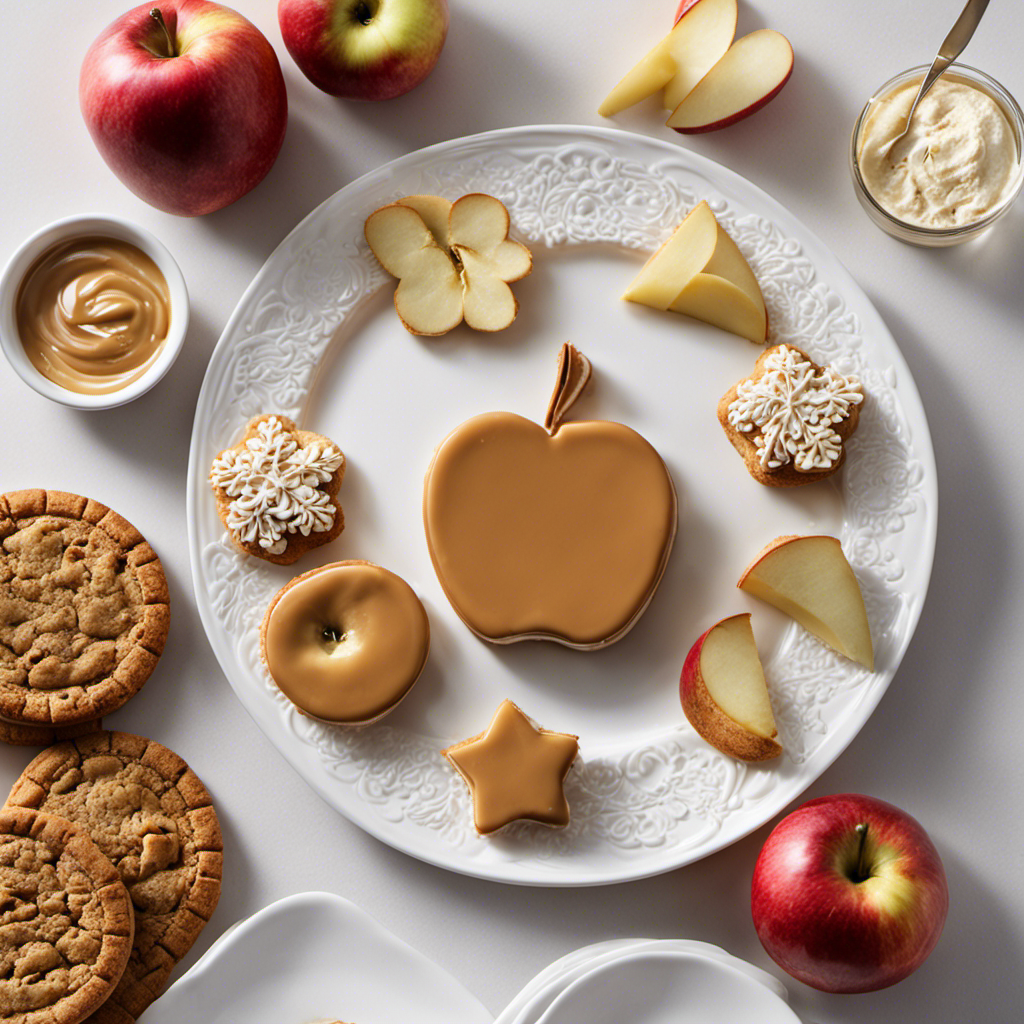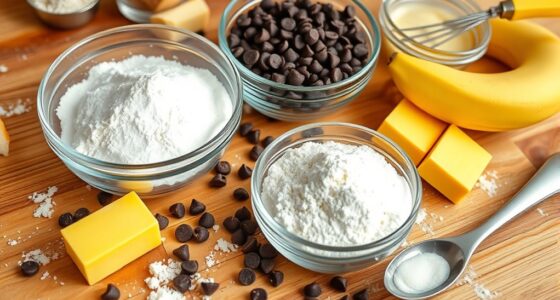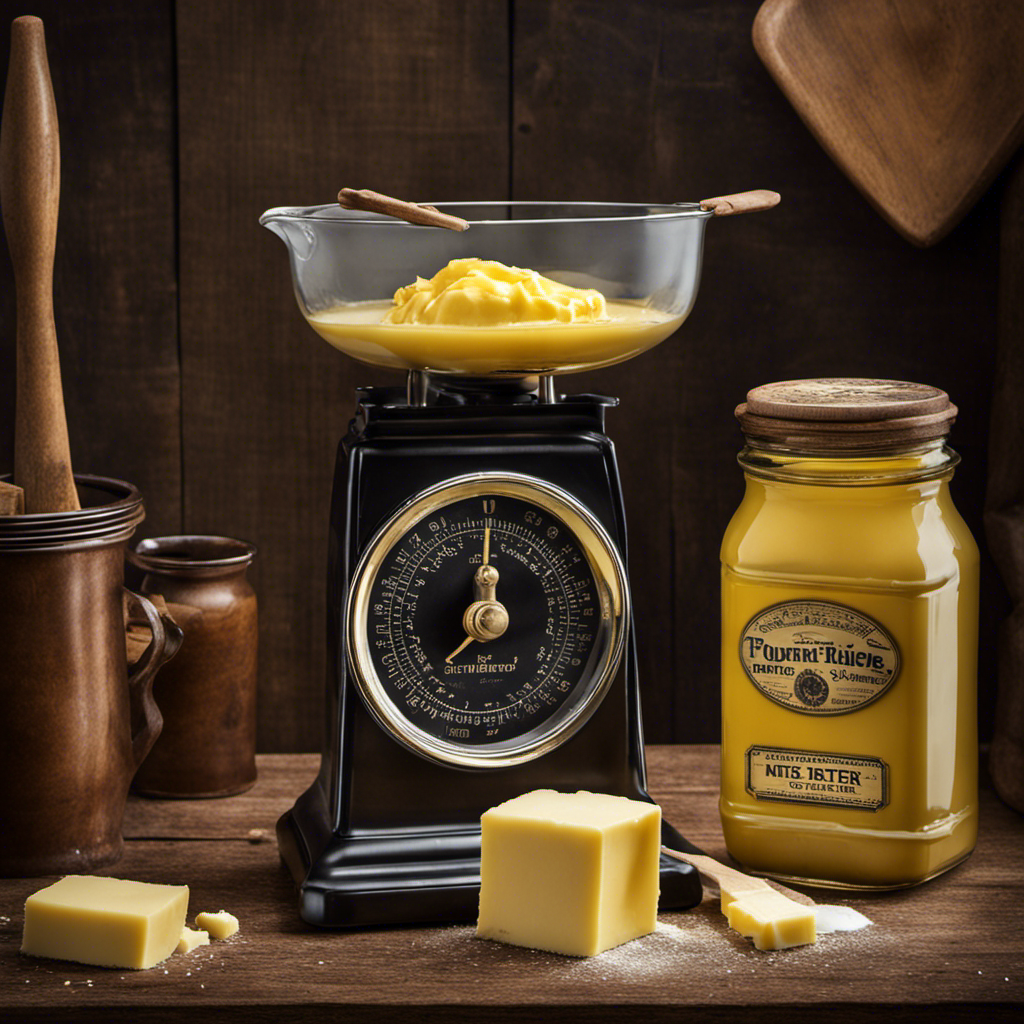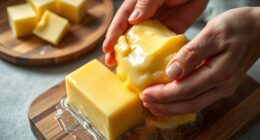I’ve unlocked the mystery behind making Culver’s famous Butter Burger right in your own kitchen. Believe me, it’s absolutely worthwhile.
The juicy, flavorful patty, the perfectly toasted bun, and the mouthwatering toppings all come together to create a burger experience like no other.
In this article, I’ll guide you through each step, from choosing the right ground beef to assembling the final masterpiece.
Get ready to impress your taste buds and become the ultimate burger connoisseur. Let’s dive in!
Key Takeaways
- Select lean ground beef or experiment with different meat blends for flavor
- Mix ground beef with salt, pepper, and garlic powder
- Use a blend of salt, pepper, and garlic powder for seasoning
- Mix in onions and breadcrumbs to retain moisture during grilling
Choosing the Right Ground Beef
When making Culver’s butter burger, it’s important to choose the right ground beef. The key to a delicious and juicy burger lies in selecting lean meat. Lean ground beef typically has a lower fat content, resulting in a healthier option that still retains its flavor.
However, it’s also worth considering experimenting with different meat blends to find the perfect combination for your taste buds. For example, mixing ground chuck with ground sirloin can add extra richness and depth to the burger. Additionally, blending ground beef with a small portion of ground pork or lamb can introduce a unique and savory twist to the flavor profile.
The possibilities are endless, and by choosing the right meat and experimenting with different blends, you can create the perfect butter burger that will leave you craving for more.
Preparing the Perfect Patty
To achieve the perfect patty, you’ll want to mix ground beef with salt, pepper, and garlic powder. This simple combination of seasonings adds a burst of flavor to the meat and enhances the overall taste of your burger.
When it comes to choosing the right patty size, consider the following tips for achieving the perfect sear:
-
Opt for a patty that is about ¾ inch thick. This thickness ensures that the patty cooks evenly and retains its juiciness.
-
Use your thumb to create a slight indentation in the center of the patty. This prevents the burger from puffing up in the middle and promotes even cooking.
-
Preheat your grill or skillet to high heat. This allows for a quick sear and locks in the juices, resulting in a juicy and flavorful patty.
-
Resist the urge to press down on the patty while cooking. This can cause the juices to escape, resulting in a dry burger.
Now that you have the perfect patty, it’s time to move on to seasoning the burger to perfection.
Seasoning the Burger to Perfection
When it comes to creating the best burger, there are three key factors that can make all the difference: the seasoning, the cooking time and temperature, and tips for achieving juicy burgers.
The right combination of seasonings can elevate the flavor of the patty, while knowing the optimal cooking time and temperature ensures that it’s cooked to perfection.
And of course, who wouldn’t want a juicy burger? With these tips, you’ll be able to create a burger that is bursting with flavor and juiciness, making every bite a delight.
Best Burger Seasoning
Using a blend of salt, pepper, and garlic powder will give your burger the best seasoning. These simple ingredients work together to enhance the natural flavors of the patty, resulting in a mouthwatering burger that is packed with deliciousness.
Here are four reasons why this seasoning combination is a game-changer for your burger:
-
Salt: The salt not only adds a savory taste to the patty, but it also helps to tenderize the meat, making it juicier and more flavorful.
-
Pepper: The black pepper adds a subtle kick to the burger, balancing out the richness of the meat and adding depth of flavor.
-
Garlic powder: The garlic powder provides a hint of aromatic goodness, infusing the patty with a delicious garlicky taste.
-
Perfect balance: When these three ingredients are combined in the right proportions, they create a harmonious blend of flavors that perfectly complement the beef, resulting in a burger that is seasoned to perfection.
Cooking Time and Temperature
The cooking time and temperature are crucial factors in achieving a perfectly cooked burger. To ensure that your burger is cooked to your desired level of doneness, it is important to know the right cooking time and temperature. Here is a table that provides a general guideline for cooking burgers:
| Burger Doneness | Cooking Time | Internal Temperature |
|---|---|---|
| Rare | 2-3 minutes | 120-125°F |
| Medium Rare | 3-4 minutes | 130-135°F |
| Medium | 4-5 minutes | 140-145°F |
Remember, these are just general guidelines and cooking times may vary depending on the thickness of the burger and the heat of your grill or stovetop. It is always a good idea to use a meat thermometer to ensure that your burger reaches the desired internal temperature. With the right cooking time and temperature, you can achieve a juicy and flavorful burger that is cooked to perfection.
Now that you know the importance of cooking time and temperature, let’s move on to some tips for making juicy burgers.
Tips for Juicy Burgers?
To achieve juicy burgers, you’ll want to consider mixing in finely chopped onions and breadcrumbs to the ground beef. This will not only add flavor but also help retain moisture during the grilling process.
Here are four tips to ensure your burgers turn out juicy and delicious:
-
Choose the right meat: Opt for ground beef with a higher fat content, such as 80/20 or 85/15, as the fat adds moisture and flavor to the patty.
-
Don’t overwork the meat: Gently mix the ingredients together until just combined. Overmixing can result in tough burgers.
-
Make thicker patties: Thicker patties, around ¾ to 1 inch thick, retain more juiciness as they require longer cooking times on the grill.
-
Use indirect grilling: Start by searing the patties over high heat for a few minutes on each side, then move them to a cooler part of the grill to finish cooking.
By following these grilling techniques and adjusting the burger patty thickness, you’ll be on your way to perfectly juicy burgers.
Now, let’s move on to cooking the burger on the stovetop.
Cooking the Burger on the Stovetop
Once the patties are formed, start cooking them on the stovetop. Cooking techniques play a crucial role in achieving the perfect burger. To ensure even cooking, preheat a skillet over medium heat. Meanwhile, let’s talk about burger flipping. It may seem simple, but there’s an art to it. Use a spatula to gently lift and flip the patty, being careful not to press down too hard, as this will release precious juices. Aim for just one flip to maintain juiciness. Here’s a handy table to guide you through the cooking process:
| Cooking Time | Flip Frequency | Internal Temperature |
|---|---|---|
| 3-4 minutes | Once | 160°F |
| 4-6 minutes | Once | 145°F (medium rare) |
| 6-8 minutes | Once | 160°F |
Mastering the art of burger flipping will elevate your cooking skills and ensure a delicious, juicy burger every time.
Toasting the Buns for Extra Flavor
When it comes to elevating the flavor of a burger, toasting the buns plays a crucial role. The bun toasting technique can make all the difference, whether you prefer a light golden crispness or a deep, toasty char.
Personally, I like to use butter to toast my buns, as it adds a rich, savory flavor that pairs perfectly with the juicy patty.
As for the preferred bun type, it really depends on your personal preference – from soft and fluffy brioche buns to sturdy and sesame seed-studded Kaiser rolls, there are endless options to choose from when it comes to finding the perfect bun for your burger.
Bun Toasting Technique
For a perfectly toasted bun, you’ll want to spread a thin layer of butter on the inside of each bun half before placing them on a hot skillet. This technique ensures that the buns become crispy on the outside while remaining soft on the inside.
Here are four tips to elevate your bun toasting game:
-
Adjust the heat: Use medium heat to prevent the butter from burning while still achieving a golden brown color.
-
Flip them: After placing the buns in the skillet, press them down gently with a spatula and flip them over after a minute or so. This helps to evenly distribute the heat and ensures an even toasting.
-
Don’t rush: Give the buns enough time to toast. This allows the butter to melt and infuse the buns with its rich flavor.
-
Experiment with toppings: Once the buns are toasted, you can get creative with your toppings. From sesame seeds to garlic powder, the possibilities are endless for adding extra flavor to your buns.
With these bun toasting techniques and bun topping variations, you’ll elevate your burger game to a whole new level.
Butter or Oil
To achieve the perfect bun toasting, you’ll want to decide whether to use butter or oil based on your personal preference and desired flavor profile. While both options can give you a deliciously toasted bun, there are some key differences to consider.
Butter, made from milk or cream, provides a rich and creamy flavor that enhances the overall taste of your bun. It adds a touch of indulgence and pairs well with a variety of fillings. Additionally, butter contains essential vitamins, such as vitamin A and vitamin D, which contribute to maintaining healthy skin and bones.
On the other hand, oil, like vegetable or canola oil, can provide a lighter and crispier texture to your bun. It is a great option for those who prefer a more neutral taste and a lighter mouthfeel. However, it lacks the distinct flavor that butter brings to the table.
Ultimately, the choice between butter and oil comes down to personal preference. If you prioritize flavor and the potential health benefits of using butter, it may be the better option for you. However, if you prefer a lighter and more neutral taste, oil can be a suitable alternative. Experiment with both options to find your perfect bun toasting technique.
Preferred Bun Type?
When it comes to the perfect burger, the bun plays a crucial role. It should be soft and fluffy, yet sturdy enough to hold all the delicious toppings and juicy patty. In my opinion, the best burger bun for a Culver’s butter burger is a classic potato bun. Its slightly sweet flavor and soft texture perfectly complement the rich and savory taste of the butter burger.
However, if you’re looking for some alternatives to the traditional potato bun, here are a few options to consider:
-
Brioche bun: With its buttery taste and light, airy texture, a brioche bun adds a touch of elegance to your butter burger.
-
Pretzel bun: For those who love a bit of a salty twist, a pretzel bun provides a unique and flavorful experience.
-
Ciabatta bun: With its rustic crust and chewy interior, a ciabatta bun adds a hearty and satisfying element to your burger.
-
Lettuce wrap: If you’re watching your carb intake or prefer a gluten-free option, you can skip the bun altogether and wrap your butter burger in crisp and refreshing lettuce leaves.
Assembling the Classic Butter Burger
Once you have all the ingredients ready, start by placing the cooked burgers on the bottom buns.
Now, let’s talk about choosing the right bun type and adding the preferred burger seasoning.
When it comes to the bun, I recommend using a soft and slightly sweet potato bun. Its fluffy texture complements the juicy butter burger perfectly.
As for the seasoning, my go-to choice is a simple blend of salt, pepper, and garlic powder. It enhances the natural flavors of the meat without overpowering it. Sprinkle the seasoning generously on both sides of the patty before grilling or frying.
This will ensure that every bite is bursting with deliciousness.
Adding Toppings for Extra Deliciousness
Now, let’s take your classic burger to the next level by piling on an array of mouthwatering toppings. Topping combinations are a great way to add new flavors and textures to your burger, making each bite a delightful surprise.
Here are four creative burger toppings that will surely elevate your culinary experience:
-
Caramelized Onions: These sweet and savory onions add a rich depth of flavor to your burger, balancing out the richness of the beef patty.
-
Crispy Bacon: Who can resist the irresistible crunch and smoky taste of bacon? It adds a delicious salty kick to your burger, complementing the other ingredients perfectly.
-
Avocado Slices: Creamy and buttery, avocado slices bring a fresh and healthy element to your burger. They add a delightful creaminess and pair well with almost any topping.
-
Spicy Jalapenos: For those who love a little heat, jalapenos are the perfect choice. They add a fiery kick that cuts through the richness of the burger, adding an exciting twist to each bite.
By experimenting with different topping combinations, you can create a burger that is uniquely yours.
Now, let’s move on to perfecting the Culver’s sauce and complete the masterpiece.
Perfecting the Culver’s Sauce
To take your burger to the next level, you’ll want to perfect the mouthwatering sauce that will bring all the flavors together. Experimenting with different condiments and exploring alternative burger sauces is a fun and exciting way to add your own personal touch to the classic Culver’s Butter Burger. The right sauce can elevate the flavors and create a truly unforgettable burger experience.
To help you in your sauce journey, here’s a table showcasing some popular condiments and their unique flavors:
| Condiment | Flavor Profile |
|---|---|
| Chipotle Mayo | Smoky and spicy |
| Garlic Aioli | Creamy and garlicky |
| BBQ Sauce | Sweet and tangy |
| Sriracha Mayo | Spicy and tangy |
These condiments can be used as is or mixed together to create your own signature sauce. So go ahead and get creative with your burger toppings and sauces. The possibilities are endless!
Now that you’ve perfected your sauce, it’s time to move on to the next section on serving and enjoying your homemade butter burger. But first, let’s take a moment to appreciate the deliciousness you’ve just created.
Serving and Enjoying Your Homemade Butter Burger
I’ve got to say, serving and enjoying your homemade butter burger is the best part of the whole process. After all the effort you put into creating the perfect patty and mastering the Culver’s sauce, it’s time to showcase your culinary masterpiece. Here are some serving techniques and pairing options to elevate your butter burger experience:
-
Toasted Buns: Start by lightly toasting the buns to add a crunchy texture and enhance the overall taste.
-
Cheese Melting: Place a slice of your favorite cheese on top of the hot patty and let it melt slightly for that ooey-gooey goodness.
-
Toppings Galore: Get creative with your toppings! From crisp lettuce and juicy tomatoes to pickles and onions, the possibilities are endless.
-
Pairing Options: Serve your butter burger with a side of crispy french fries, a refreshing coleslaw, or a classic milkshake for the ultimate indulgence.
Frequently Asked Questions
Can I Use a Different Type of Meat Other Than Ground Beef for This Recipe?
Using a different type of meat, like ground turkey or chicken, is an alternative for this recipe. Pros include leaner and healthier options, but cons may include differences in flavor and texture.
How Long Should I Let the Ground Beef Sit Out at Room Temperature Before Making the Patties?
I usually let the ground beef sit out at room temperature for about 30 minutes before making the patties. This allows it to come to room temperature and ensures even cooking. Properly seasoning the ground beef is key to achieving the perfect level of doneness when cooking butter burgers.
Is It Necessary to Toast the Buns or Can I Skip This Step?
To toast or not to toast: is it necessary for the buns in a butter burger recipe? Can I skip the toasting step in making a Culver’s butter burger? Personally, I find that toasting the buns adds a delicious crunch and enhances the overall flavor of the burger.
Can I Substitute the Culver’s Sauce With Another Type of Sauce?
Yes, you can substitute Culver’s sauce with other options like mayo, ketchup, or mustard. It all depends on your preference. Experiment with different sauces to find the one that complements your Butter Burger the best.
How Can I Store Any Leftover Butter Burgers for Later Consumption?
To store leftover Butter Burgers, wrap them individually in aluminum foil or place them in an airtight container in the refrigerator. When reheating, I recommend using a toaster oven or stovetop to maintain the burger’s deliciousness.
Conclusion
In conclusion, crafting a delectable Culver’s butter burger is a culinary conquest that will leave your taste buds tantalized. The combination of carefully chosen ground beef, perfectly seasoned patties, and toasty buns creates a symphony of flavors that will satisfy even the most discerning palate.
With the addition of mouthwatering toppings and the secret Culver’s sauce, this burger reaches new heights of deliciousness. So gather your ingredients, fire up the stovetop, and embark on a burger adventure that will have you savoring every succulent bite.
Indulge in the buttery bliss of a homemade Culver’s butter burger and experience pure culinary bliss.
